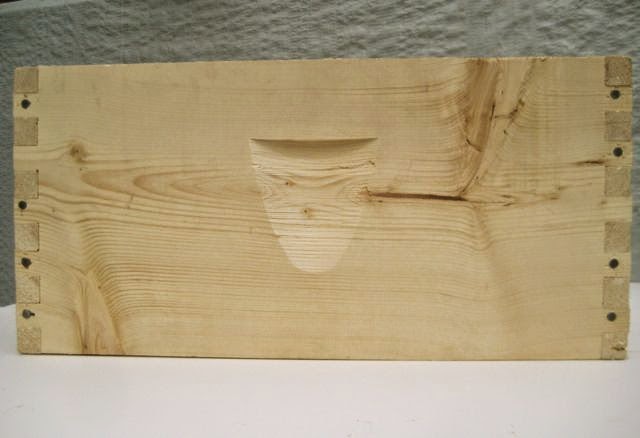Sometimes we get blogging about beekeeping topics and forget that some of our readers are brand new to beekeeping. Sooooo. . . This post will be about boxes. Oh, and beekeeping jargon.
This is a box.
It is also called a hive body, a super, a "Langstroth," or a hive.
A hive body is the bottom box in a stack of boxes, and sits on top of the bottom board. It is typically where the queen lays eggs. A new hive starts with a bottom board, 1 box with 10 frames (the hive body), and the lid on top of that. Later in the season, more boxes are added on top of the hive body box and below the lid.
Supers are any boxes above the hive body. Supers are typically where bees store honey.
Mr. Langstroth invented the box with removable frames. The Langstroth box is standard in the beekeeping industry. Other non-Langstroth styles include top bar hive, Worre hive, etc. We use Langstroth boxes.
A hive is the place where bees live, be it a box, swamp cooler, or hollow log.
Boxes come in deep, medium, and shallow. Deeps, mediums, and shallows have the same length and width, but different depths. They are stackable. By volume, 3 deep boxes is equivalent to 5 medium boxes.
There is much debate on which box size is best. Frankly, it doesn't matter to the bees. We choose to run deep boxes, but others who prefer lighter weight run medium boxes. (See post about deep vs medium boxes.)
Some beekeeping catalogues call deep boxes "hive bodies" and the mediums and shallows "supers." We use deep boxes as hive body boxes and as supers. Having the same size boxes helps us keep things uniform.
Boxes are open in the middle so that when they are stacked, bees can move between boxes without restriction.
Boxes hold frames. There is a rabbet groove cut in the end of each box to hold the frames. We cut this rabbet AFTER assembling the boxes to make a stronger joint.
10 frames per box is standard, but some beekeepers choose to put 9 frames in each box. Some people prefer 8-frame equipment because it is lighter, but still uses deep frames. 8-frame boxes hold 8 deep frames and are a different size from 10-frame boxes. We also use deep 5- and 6-frame hive nucleus boxes. Below, the box on the left is a 10-frame box, and the two on the right are 5-frame nuc boxes.
When assembling our boxes, we put the rough side of the wood IN. This is to encourage bees to collect and smear propolis all over the inside of the boxes. Propolis is an important part of bees defense against disease.
Boxes have handholds cut into four sides.
Box joints are dovetail or tongue and groove joints.
The boxes below are stacked, but they are all hive body boxes. Each box holds an individual colony. There is a lid and bottom board for each box. We've stacked them close to keep them warm for winter.
Below is our invention, the Barn Hive, with a 10-frame langstroth box below and a 5-frame nuc box above.
It is a good idea to paint the outside of boxes with outdoor paint or stain to protect them from the weather. Pay special attention to the box joints, which can collect moisture and expand without paint.

























































































